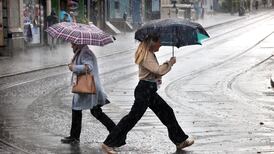IMAGINE a wine tasting where half a million bottles are laid out for sampling, in a space so vast you have to walk three miles just to catch a first glimpse of what is there. And imagine colliding with wine's brightest stars every few yards. Look, isn't that Randall Grahm, the original Rhone ranger? There's Andre Lurton, the king of white Bordeaux, of good Irish wine wild goose stock, and Marcel Guigal without a drop left to sell, and Jancis Robinson with a haircut. That's Vinexpo for you - the biggest, glitziest wine fair in the world, wearing out shoe leather all this week in Bordeaux.
This monster event was launched in 1981 as a biennial affair, dedicated mainly to French wines. Now, although the French occupy the most space, Vinexpo is an international as can be with 2,000 exhibitors and 45,000 visitors from 40 countries. "You simply have to be here," they say. It's Cannes for the drinks trade, complete with extraordinary stage sets (a pastel-washed Provencal village, a Parisian brasserie, a giant fish tank). There may be fewer nymphets, but there's certainly more champagne.
The buzz this year is that the wine business is in rude health - helped both by economic buoyancy and all the recent claims about the health benefits wine bestows: that has kept smiles on faces that should have betrayed the pain of heel blisters, or a week of hangovers incurred at dangerously lavish parties.
Anyway, in homage to the home of Vinexpo, I've been thinking this week about Bordeaux. Not red Bordeaux - that's far too depressing. With prices doubling in the past five years as the Far East falls thirstily upon all the best clarets (and not a whisper to suggest the frenzy is abating), bottles that might once have been just about affordable for a special occasion will now carry the sort of price tags that belong in Tiffany's window - especially by the time we see the promising 1996 vintage. Right now, white Bordeaux is much more of a good news story.
It's the liquid equivalent, in a sense, of rags to riches - threadbare plonk to palatable, pleasurable, well-made wine. Leave out of the equation the great sweet white wines of Bordeaux which have been heaped with honour and glory for centuries. What we're dealing with here are the region's dry white wines - the poor relations, until not so long ago, of the strutting, high-profile reds. If you're old enough to remember sour, sulphurous Entre-Deux-Mers and white Bordeaux so flabby that it couldn't stand up never mind strut, you will doubtless feel they deserved to be sidelined. But so vastly have the fortunes of white Bordeaux improved over the past 10 to 15 years that the wines have a new respectability. They're the poor relations who have had cash stashed under the bed all along for a big rebuilding programme.
In a recent issue of his influential magazine The Vine, Clive Coates writes of the "revolution" which has improved quality right across the board. Changes in the vineyard and in winemaking techniques have produced much cleaner, fresher wines, designed to be drunk younger. To promote the quality end, the Pessac-Leognan appellation was established in 1987 within the Graves, neatly encompassing all the area's most famous chateaux. But the most exciting thing for everyday drinkers is that the new emphasis on quality and drinkability has filtered right down to inexpensive wines - examples of what Coates describes as "the new wave white Bordeaux".
What's in it, as they say, for us? Styles vary considerably, since the wines can be made from 100 per cent Sauvignon Blanc, 100 per cent Semillon or any combination in between, with the lesser white grape Muscadelle sometimes accounting for a minor proportion of the blend. Sauvignon provides fresh, fruity aromas and tingling acidity. Semillon - the grape of sweet white Bordeaux - has a creamy, waxy quality which delivers what American winemakers and marketing people love to term "mouthfeel" - making the wine attractively smooth and round. With fermentation in oak barrels the creamy richness intensifies. Often a producer will make both unoaked and oaked wines - the first crisp and aromatic, the second style more complex (and more costly).
The great benefit, to us drinkers, is a new territory to explore, full of variation and potential. If you're ready to defect to Anything But Chardonnay, white Bordeaux is out there winking at you; it may just be a matter of wading against the flow to find it. If you adore white Burgundy, on the other hand, but baulk every so often at the prices, you'll find the better white Bordeaux often deliver better value. And now's the time to go prospecting. The light, zesty styles make delicious summer drinking on their own or with salads and seafood, while the slightly more rounded wines show their strength with other still summery food like fritto misto or a chicken pie. Or tasty air-dried ham like jambon de Bayonne - which brings us back to Bordeaux. Roll on the next Vinexpo!





